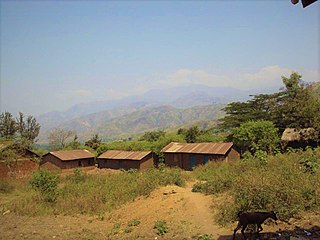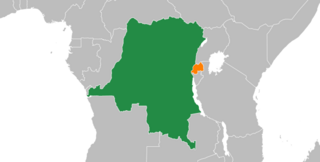The earliest known human settlements in what is now the Democratic Republic of the Congo have been dated back to the Middle Stone Age, approximately 90,000 years ago. The first real states, such as the Kongo, the Lunda, the Luba and Kuba, appeared south of the equatorial forest on the savannah from the 14th century onwards.

South Kivu is one of 26 provinces of the Democratic Republic of the Congo (DRC). Its capital is Bukavu.

Goma is the capital and largest city of the North Kivu Province in the eastern region of the Democratic Republic of the Congo (DRC). It is located on the northern shore of Lake Kivu, next to the Rwandan city of Gisenyi. It shares its borders with Bukumu Chiefdom to the north, the Republic of Rwanda to the east, Masisi Territory to the west, and is flanked by Lake Kivu to the south. The city lies in the Albertine Rift, the western branch of the East African Rift System, and lies only 13–18 km (8.1–11.2 mi) south of the active Nyiragongo Volcano. With an approximate area of approximately 75.72 square kilometers, the city has an estimated population of nearly 2 million people according to the 2022 census, while the 1984 estimate placed the number at 80,000.
Banyamulenge is a community from the Democratic Republic of the Congo's South Kivu province. The Banyamulenge are culturally and socially distinct from the Tutsi of North Kivu, with most speaking Kinyamulenge, a mix of Kinyarwanda, Kirundi, Ha language, and Swahili. Banyamulenge are often discriminated against in the DRC due to their Tutsi phenotype, similar to that of people living in the Horn of Africa, their insubordination towards colonial rule, their role in Mobutu's war against and victory over the Simba Rebellion, which was supported by the majority of other tribes in South Kivu, their role during the First Congo War and subsequent regional conflicts (Rally for Congolese Democracy–Goma, Movement for the Liberation of the Congo, National Congress for the Defence of the People, and more importantly for the fact that two of the most influential presidents of their country declared them as enemy of the State both in 1996 and 1998.

The Alliance of Democratic Forces for the Liberation of Congo-Zaire, also known by the French acronym AFDL, was a coalition of Rwandan, Ugandan, Burundian, and Congolese dissidents, disgruntled minority groups, and nations that toppled Mobutu Sese Seko and brought Laurent-Désiré Kabila to power in the First Congo War. Although the group was successful in overthrowing Mobutu, the alliance fell apart after Kabila did not agree to be dictated by his foreign backers, Rwanda and Uganda, which marked the beginning of the Second Congo War in 1998.

The First Congo War (1996–1997), also nicknamed Africa's First World War, was a civil war and international military conflict which took place mostly in Zaire, with major spillovers into Sudan and Uganda. The conflict culminated in a foreign invasion that replaced Zairean president Mobutu Sese Seko with the rebel leader Laurent-Désiré Kabila. Kabila's unstable government subsequently came into conflict with his allies, setting the stage for the Second Congo War in 1998–2003.
Laurent Nkunda is a former General in the Armed Forces of the Democratic Republic of Congo (DRC) and is the former warlord operating in the province of Nord-Kivu, sympathetic to Congolese Tutsis and the Tutsi-dominated government of neighbouring Rwanda. Nkunda, who is himself a Congolese Tutsi, commanded the former DRC troops of the 81st and 83rd Brigades of the DRC Army. He speaks English, French, Swahili, Kinyarwanda, Lingala and Kinande. On January 22, 2009, he was put under house arrest in Gisenyi when he was called for a meeting to plan a joint operation between the Congolese and Rwandan militaries.

WalunguTerritory is a territory located within the South Kivu Province in the eastern part of the Democratic Republic of the Congo (DRC). Situated approximately 40 km from Bukavu, the capital of South Kivu Province, it shares borders with Kabare Territory to the north, Mwenga Territory to the south, Uvira Territory and the Ruzizi River, as well as the Republics of Rwanda and Burundi to the east, and Shabunda Territory and part of Kabare Territory to the west. According to the 2018 national census, the region has a population of 716,671, with 672,436 residing in the Ngweshe Chiefdom and 44,235 in the Kaziba Chiefdom. Spanning an area of 1,800 km2, Walungu Territory has a population density of 398 inhabitants per square kilometer.
The Democratic Republic of the Congo (DRC) is a source and destination country for men, women, and children subjected to trafficking in persons, specifically conditions of forced labor and forced prostitution. The majority of this trafficking is internal, and much of it is perpetrated by armed groups and government forces outside government control within the DRC's unstable eastern provinces.
The DRC Mapping Exercise Report, or the Democratic Republic of the Congo 1993-2003 UN Mapping Report, was a report by the United Nations within the Democratic Republic of the Congo in the wake of the armed aggressions and war which took place between March 1993 and June 2003. Its aim was to map the most serious violations of human rights, together with violations of international humanitarian law, committed within the Democratic Republic of the Congo. In doing this it was to assess the capacities within the national justice system to deal appropriately with such human rights violations and to formulate a series of options aimed at assisting the government of the Democratic Republic of the Congo in identifying appropriate transitional justice mechanisms to deal with the legacy of these violations. It contained 550 pages and contained descriptions of 617 alleged violent incidents.
Kanyabayonga is one of the groupements (groupings) within the Bwito Chiefdom in the Rutshuru Territory of North Kivu Province in the eastern Democratic Republic of the Congo (DRC). The region has suffered from continued violence between the army and rival militias since 1993.

Uvira Territory is a territory in South Kivu, Democratic Republic of the Congo. It is bordered by Walungu Territory to the north, Mwenga Territory to the west, Fizi Territory to the south, and Burundi and Lake Tanganyika to the east. Its capital is Uvira.
Kinyandonyi is a village in the Rutshuru Territory of the North Kivu Province, Democratic Republic of the Congo. Kinyandonyi is situated 10 km east of the city of Kiwanja in Bukoma groupement, in the Bwisha Chiefdom and 85 km north of the capital of the province Goma. The region is inhabited by the Hunde people as well as some remaining autochthonous populations of African Pygmies, including the Twa people and the Mbuti people. In addition to the Hunde, Twa, and Mbuti, there are other ethnic groups, including the Nyanga, Lega, Kumu, Hutu and Tutsi.

Kamanyola is one of the groupements (groupings) within the Ngweshe Chiefdom of the Walungu Territory. It is located in the Ruzizi Plain in the South Kivu Province of the Democratic Republic of the Congo (DRC), sharing a border with Rwanda and Burundi. Kamanyola stands at a height of 901 meters and is closely situated to the suburb of Mwaro and the village of Mubombo.
Bwegera is a village in the Bafuliiru Chiefdom in the Uvira Territory of South Kivu Province, Democratic Republic of the Congo. Bwegera has an elevation of 952 meters and is situated in the vicinity of the Kakamba and Nyaruhuhuma villages. The region It's crossed by Lake Tanganyika, providing a vital source of water and transportation for the local inhabitants. Bwegera is rich in building materials such as rubble, sand, and baked bricks, making it an ideal location for construction and development. The region also encompasses a vast rural area where agriculture, animal breeding, and fishing are the primary means of livelihood.

Lubarika is a village situated in the hills and high plateaus of Bafuliiru Chiefdom in Uvira Territory, located in the South Kivu Province in the eastern part of the Democratic Republic of Congo (DRC). It sits at an elevation of 969 meters above sea level and is near the villages of Murunga and Nyakagobe II. Lubarika is a predominantly agricultural region with large hectares used for subsistence agriculture. Agriculture is practiced by an extensive segment of the population. The products grown are mainly intended for domestic consumption and commercialization. Moreover, fishing is carried out artisanally in Lake Tanganyika by the local population.
The Kasika massacre took place on August 24, 1998, in the villages of Kasika, Kilungutwe, Kalama, and Zokwe, located in the Luindi Chiefdom of the Mwenga Territory in the South Kivu Province, situated in the eastern part of the Democratic Republic of the Congo (DRC). Troops from the Rally for Congolese Democracy (RCD) and Rwandan Patriotic Army (RPA), primarily composed of Tutsi armed forces, killed over 1,000 civilians, predominantly belonging to the Nyindu community.
The Bafuliiru Chiefdom, formerly known as Chefferie des Bafulero, is a chiefdom located in the Democratic Republic of the Congo (DRC). It is situated in the Uvira Territory, which is part of the South Kivu Province in eastern DRC.

The Ngweshe Chiefdom is a chiefdom located in Walungu Territory, within the South Kivu Province of the Democratic Republic of the Congo (DRC). It shares borders with Kabare Territory to the north, Rwanda and Burundi to the northeast, Mwenga Territory and Shabunda Territory to the south, and Kaziba Chiefdom to the east. According to the territory's 2018 annual report, the chiefdom has an estimated population of 672,436.

Modern relations between the Democratic Republic of the Congo and Rwanda have origins that date back to the colonial era. Sharing a border that is 221 km in length, the two countries were both colonial possessions of Belgium between 1919 and 1960, and were impacted by the two world wars. Both Rwanda and the Congo experienced violent upheavals during their first years of independence, with the Congo being left with a weak central authority, and Rwanda dealing with periodic raids and incursions from expelled Tutsi rebels in the east of the Congo.











